HENRY TERRELL, Contributing Editor
As demand for oil and gas continues to grow, and traditional sources of hydrocarbons become scarcer, the drilling industry is encountering an increasing range of challenging applications—hard rock formations, long laterals in unconventional plays, harsh extended-reach deepwater wells and inter-bedded reservoirs.
The expansion of shale play exploitation over the last decade has been so rapid that production records are still being set. Unconventional shale plays have accounted for the largest year-on-year growth in U.S. crude oil production between 2012 and 2013, the largest in any country. Understanding this, shale operators are constantly trying to push the envelope, wanting to drill further and faster, and with better control. Even with significant improvements in drilling in recent years, shale play wells still only account for half of producing footage. So the challenge remains to drill the most payzone footage in the shortest amount of time.
Innovation is driven by the search for bit designs that can adapt to hard rock formations; long laterals in unconventional shale plays; harsh extended-reach deepwater wells; and inter-bedded reservoirs—all at improved efficiency and higher ROP.
NATIONAL OILWELL VARCO
NOV ReedHycalog’s SpeedDrill bit delivers stability and drilling efficiency improvements through the use of a concentric, two-stage, dual-diameter concept, initially developed from data generated by numerous, bi-center bit runs Fig. 1.
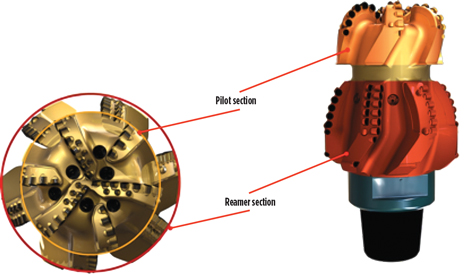 |
| Fig. 1. NOV Downhole’s SpeedDrill bits are concentric, dual-diameter fixed-cutter drill bits. |
|
The SpeedDrill bit initially drills a smaller hole with the pilot section, which has the effect of stress-relieving the surrounding rock. The reamer section subsequently engages this stress-relieved rock, enlarging the hole to the required diameter in a manner that requires less energy, resulting in more efficient drilling.
In contrast to conventional, single-diameter PDC bits, which typically provide 50% gauge pad contact with the wellbore, SpeedDrill bits offer 100% contact by utilizing pilot and reamer sections that are oriented to provide continuous wellbore contact through the gauge pads. This increased gauge contact improves lateral stability and helps prevent the initiation of bit whirl.
A UK operator drilled an exploratory well last year in a remote area west of the Shetland Islands. In addition to the technical challenges posed by the harsh location and weather conditions surrounding it, the field features a layer of very hard, volcanic rock above the reservoir. Drilling volcanic rock can result in considerable vibration in the BHA and the drillstring, resulting in drill bit and downhole tool failure.
The operator selected a six-bladed SpeedDrill bit with 16-mm cutters to drill the intermediate section above the reservoir, including the difficult volcanic formation. Run on a low-speed, high-torque motor BHA, the system provided sufficient energy, stability and durability to successfully drill the entire 12¼-in. section, a distance of more than 1,000 m (3,280 ft). This was accomplished using only one BHA and bit, drilling at an average ROP of 11.3 m/hr (37 ft/hr). The final part of this interval comprised 30 m of very hard olivine basalt, which the bit drilled at up to 10 m/hr (32.8 ft/hr).
NOV’s Downhole division introduced the Seeker S-Series drill bit in late 2012, which has been designed specifically for shale play applications. The S-Series takes the directional capabilities a step further by minimizing the bit length to provide superior directional response, when needed. The design incorporates thin blades with increased height to maximize open-face volume, allowing the high volume of cuttings to flow away from the bit face. The S-Series design also involves precise positioning of the nozzles to provide optimal directed flow to complement the blade and bit body geometry, further supporting the efficient evacuation of cuttings up the annulus.
Leading edge cutter technology is incorporated in each design, capitalizing on the directional capabilities of Seeker drill bit cutting structures. These structures are designed to ensure adequate cutter exposure for maximum ROP, and optimized backrakes and siderakes, to provide durability and stability. The Seeker S-Series uses drill bit directional features known as SmoothTorque laterals—PDC components placed on the shoulder to enhance directional capabilities and increase durability. Finally, improved DuraShell Hardfacing allows for the use of ultra-dense tungsten carbide material to enhance bit body durability, increasing the life of the bit for multiple sections or extended laterals.
Shale plays have diverse geological characteristics, including depth, thickness and content, which make it difficult to provide a one-bit-fits-all solution. The best approach is to engineer application-specific drill bits that can address the particular challenges of each shale play. Further engineering of the Seeker S-Series bit design allowed for the optimization of the drill bit for individual applications, answering the unique challenges of each.
One success was demonstrated in the Eagle Ford shale of Dimmit County, Texas. An 8¾-in. SK513 Seeker S-Series bit drilled 7,826 ft while maintaining an average ROP of 69.7 ft/hr. The design achieved a record run with this operator, and it drilled to depth with only one bit. Another success was demonstrated in the Bakken shale of Richland County, Mont. A 6-in. SK613 Seeker S-Series bit drilled 10,110 ft while maintaining an average ROP of 77.4 ft/hr. This was a 76% increase in interval drilled and a 46% ROP improvement over average offset bits.
The TSIMIN and KAB fields are in the southwestern unit of the marine region of the Mexican state of Tabasco. Wells drilled here must contend with a formation that is typically identified as hard and difficult within the middle Cretaceous. This section has presented numerous drilling challenges, including difficulties maintaining cutting structure durability and tool longevity. The formation contains a band of limestone with up to 30% chert content and a hard interbedded section of mudstone and limestone lithology with a Confined Compressive Strength (CCS) ranging from 25 to 45Ksi.
In this area, many different drill bit technologies have been tried, but so far, none have excelled. Diamond impregnated bits, run on turbines, have shown good durability but have limited ROP. PDC bits run faster than impregnated diamond bits, but lack sufficient durability. Roller cone insert bits have the high risk of moving parts, but hybrid technology drill bits with different configurations show the greatest potential for benefit in the middle Cretaceous section.
NOV’s Downhole division proposed the use of its FuseTek hybrid drill bit for this challenging section, as these hybrid bit designs have showed great potential in terms of durability and ROP since their introduction. Communication with the operator resulted in a series of changes and recommendations to improve the initial trials and achieve longer runs.
After implementing these changes, good results were achieved in TSIMIN field, where the technology was compared with diamond impregnated bits, a hybrid-PDC bit and a conventional PDC bit. Utilizing FuseTek drill bit technology, the typical number of bit runs for this section were reduced from four to two bits.
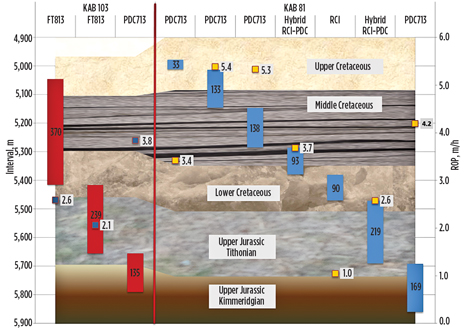 |
| Fig. 2. KAB offset performance comparison, 8.5 in. section. |
|
In KAB field, FuseTek bit technology was compared to another hybrid technology. This field shares the difficulties of the TSIMIN wells—interbedded lithologies, chert and high CCS. Figure 2 shows the performance of the FuseTek bits against a series of bit types and designs for the 8.5-in. section. The clear advantage in the section is shown between 5,100 m and 5,500 m, where the FuseTek bits drilled longer sections than the offset bits. In total, three NOV bits were used to complete the 8.5-in. section, compared to seven bits of other types.
FuseTek bits, featuring the fusion of PDC and diamond impregnated bit technologies, have proven to be a reliable hybrid solution, as these bits have no moving parts and have the flexibility to be run on different drive types. Additionally, they don’t have coatings that can flake off. The robust bits can be used in applications where PDC drill bits were not considered sufficiently durable, where roller cone reliability is in question, and diamond impregnated bits have not demonstrated sufficient ROP to be applied on a consistent basis within the middle Cretaceous.
HALLIBURTON
Halliburton Drill Bits and Services has released a new premium bearing system that is a synergy of innovative features designed to significantly enhance roller cone bit life and reliability in the most challenging applications, Fig. 3. At the heart of the new system is a dual-seal, dual-pressure compensation arrangement.
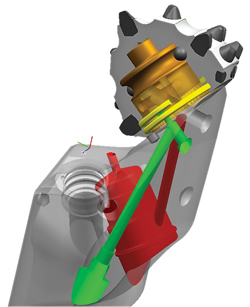 |
| Fig. 3. The premium bearing system includes two independent pressure-compensation systems that are isolated from the external environment. |
|
Downhole pressure compensation, which equalizes the pressure on each side of the seal, is essential to maximize seal life and prevent extrusion damage and excessive wear. A dual-seal configuration requires that the lubricant between the two seals must be equalized to the pressure of the grease in the bearing system and in the downhole environment. The premium bearing system from Halliburton provides a solution by including two independent pressure compensation systems that are completely isolated from the external environment, thus eliminating the ingress of drilling mud and abrasives between the seals that is inherent in other dual-seal designs. The “floating ball compensator,” which manages the grease volume between the seals, allows precise, bi-directional pressure compensation while remaining compact enough to be used in smaller journal bearing bit sizes. Additionally, the independent compensation systems allow the use of different lubricants, each ideally custom-designed, to be used in the main bearing system and the gap between the seals.
The new premium bearing system utilizes grease that has been shown in laboratory testing to increase load capacity by 20% or more, and a “seal-friendly” lubricant between the two seals that reduces wear, temperature generation and extends bit life. The OCP (Optimized Contact Pressure) seals are designed to place the highest contact pressures at the edges of the dynamic sealing surface to prevent drilling mud and debris from migrating under the sealing face and causing premature wear. The optimized pressure profile maximizes the sealing capacity while reducing temperature and torque generation. In laboratory tests, the OCP seals lasted 53% longer, with a 24% reduction in torque and 16% decrease in operating temperature. Numerous successful bit runs over a wide variety of applications demonstrate that the new premium bearing system has significantly extended bit life, resulting in more footage drilled and increased bit reliability.
SMITH BITS
The industry’s first rolling polycrystalline diamond compact (PDC) cutter extends drill bit run life by staying sharp longer when drilling in abrasive environments, Fig. 4. By rotating a full 360° while drilling, the ONYX 360 rolling PDC cutter from Smith Bits, a Schlumberger company, increases footage drilled per run by improving drill bit durability and extending bit life. Strategically placed in the highest wear areas of the drill bit’s cutting structure, the rolling PDC cutter uses its entire diamond edge to shear the formation as the bit rotates, thus distributing wear over its entire circumference. This unique rotation allows the cutter’s diamond edge to stay sharp longer, which increases penetration rates and extends drill bit life when compared to a bit fitted only with premium fixed PDC cutters.
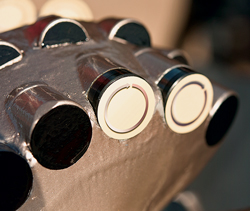 |
| Fig. 4. The ONYX 360 rolling PDC cutter greatly increases bit durability by revolving 360°. |
|
The 360° rotation of the ONYX 360 cutter also reduces friction heat buildup, which results in less wear and fewer bit replacement trips. The cutter number and placement can be customized to maximize durability in the high-wear areas of the bit cutting structure. The orientation of the ONYX 360 cutter in the bit blade—relative to its contact with the formation and the bit’s drilling force—ultimately drives efficient rotation of the cutter. An internal shaft is used by the rolling cutter, which is fully contained within an integrated housing, to ensure continuous rotation and cutter retention during drilling. The cutters can be integrated into a PDC bit cutting structure without changing cutter or bit size.
The Stinger Conical Diamond Element (CDE) enables high-point loading to fracture rock more efficiently during drilling for increased ROP. The CDE was developed using a proprietary synthetic diamond manufacturing technology, and has an ultra-thick polycrystalline diamond layer that is significantly thicker than conventional polycrystalline diamond compact (PDC) cutters. The element’s shape is optimized for strength in axial compression. By placing the Stinger element centrally in a PDC drillbit cutting structure, the conical element improves performance by crushing formation core at the borehole center, thus improving the rate of penetration. A synthetic, ultra-thick diamond material layer is used to increase the element’s durability, while also enhancing rock destruction at the center of the bit’s cutting structure.
To ensure that the incorporation of the Stinger element into a PDC bit would maximize efficiency, engineers used the Smith Bits IDEAS integrated drillbit design platform to enhance PDC performance by placing the element at the center of the PDC bit’s cutting structure. To measure the effectiveness of adding the element to a reconfigured PDC bit’s cutting structure, the IDEAS platform simulated drilling in shale formations comprised of limestone and sandstone. In these tests, the PDC bits equipped with the Stinger element demonstrated increases of as much as 18%. The Stinger CDE can be used in a wide variety of formation types and compressive strengths, in addition to any BHA configuration—rotary, motor or rotary-steerable drive systems.
VAREL
Varel International has introduced the IMax series impregnated drill bits, which are engineered, designed and built to deliver fast, long-lasting performance. The design process and diamond distribution in the new line is controlled along the bit profile for optimum coverage, providing for longevity. For durability, the combination of segmented and impregnated blades in hybrid designs yields maximum toughness. The series has gone through an extensive hydraulic validation process with CFD, to provide for optimized cooling/cleaning of the parts.
Diamond distribution and quality are crucial to bit performance. Varel began by commisioning encapsulated diamonds, which are handled by using a specialized sintering process. This process is optimized to resist diamond degradation, due to temperature or diamond graphitization. The quality process continues by using a pelletized diamond technique to optimize stone distribution. This approach avoids diamond aggregates and areas with low diamond concentration. The result is a more homogenous distribution of diamond through crucial areas of the cutting structure. Pelletizing also protects diamonds during heat cycles for longer useful life.
To minimize segment porosity, the latest sintering technology is utilized to incorporate diamonds in specific segmented designs, minimizing diamond degradation. The result is a combination of these segments and impregnated blades, whether infiltrated or sintered powder-metal matrix bits, with diamond of specific selected screen sizes uniformly distributed throughout the entire crown. A specialized controlled-atmosphere furnace has been added to the manufacturing process to produce these bits. This controlled atmosphere is an additional step to prevent the diamond from degradation.
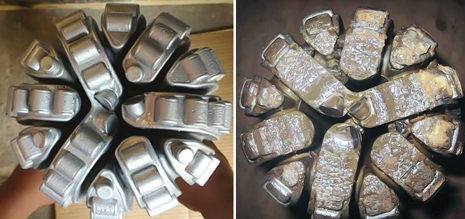 |
| Fig. 5. With this single-run performance, the VI1213DGX bit exceeded all previous 6-in. runs in Bolivia to establish new ROP, footage and CPF records in one single shot. When pulled (right), the bit was dull-graded as re-runnable. |
|
Varel’s 6-in. IMax series impregnated bit, VI1213DGX, was designed to drill effectively on a turbine in 6-in. hole through a formation composed mainly of sandstone and naturally fractured quartz, Fig. 5. In its initial application in Bolivia, where hard and abrasive formations limit penetration rate and accelerate bit wear, the bit set new benchmarks in footage and ROP while delivering the lowest cost per foot to date for the slim hole section. The objective was to drill as much footage as possible from 17,080 ft MD, while maintaining an average ROP between 5 and 6.5 ft/hr.
The matrix body bit features 12 blades, each incorporating 13-mm, diamond-impregnated cylinder blocks and 13-mm, Vulcan PDC cutters, a combination designed to withstand wear while delivering effective performance in high-compressive-strength formations. To accommodate the extreme drilling conditions in this turbine application, bit hydraulics were optimized to improve mud circulation for better cooling and cleaning.
In its debut run, the bit was run in hole on the turbine and drilled to 18,490 ft MD, in a single run of 1,410 ft, for a 120% increase in footage drilled, compared to the previous-best 6-in. run. In addition, the bit achieved instantaneous penetration rates ranging from 6.5 to 13 ft/hr, to deliver a final outstanding average ROP of 8 ft/hr, again outperforming the next-best ROP.
BAKER HUGHES
The Hughes Christensen IRev infinite revolution impregnated diamond bit is commercially available worldwide, Fig. 6. The bit has consistently improved run life while minimizing trips and the number of bits required when drilling in hard and abrasive intervals, including sandstones and complex sections interbedded with softer shales. The IRev bit features a completely new cutting structure that keeps the bit in the hole longer to complete the interval. Diamond impreg posts allow for a more aggressive rate of rock removal, enabling drilling in formations where PDC bits typically have not performed.
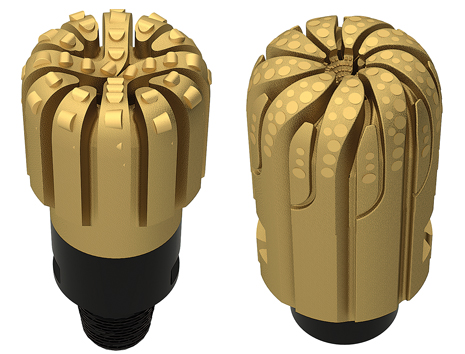 |
| Fig. 6. The IRev Impreg bit is engineered for extremely hard and abrasive applications, where PDC bits typically have not performed well. It also extends run life and enhances performance. |
|
As diamonds in the posts and blades wear away, new diamonds are exposed to enhance performance and further extend bit life. Available in 55/8- to 14¾-in. sizes, these bits are designed to precisely match application requirements, and can accommodate a full range of challenging formations.
The IRev bit can be used with both turbine and high-speed motors, including the Baker Hughes Navi-Drill X-treme HS motor. Power sections cover the same speed range as a turbine while providing higher torque and increased flexibility. This additional torque, at the same RPM range, permits the use of a higher weight on bit than would be possible with a turbine, enabling greater ROP.
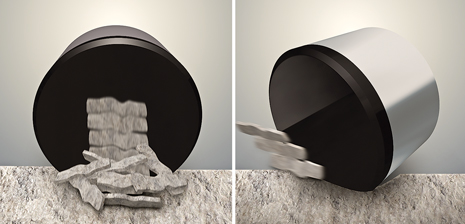 |
| Fig. 7. Unlike flat conventional profiles where cutters bluntly plow through the formation, left, Ulterra’s CounterForce arrangement angles the cutting elements so they slice through the rock more efficiently and sharply. This reduces reactive torque and improves stability for better toolface control and wellbore quality. |
|
The Baker Hughes StayCool multidimensional cutter technology reduces drilling costs by drilling more efficiently, decreasing the days it takes to complete the well, and by minimizing friction on the cutter face and improving ROP. Run on Hughes Christensen Talon PDC bits, StayCool cutters’ non-planar diamond table geometry and StaySharp polished cutter base technology enhances performance in key applications.
In more challenging environments like interbedded sandstones and carbonates, bit performance is directly related to cutter technology and its ability to withstand heat. StayCool technology reduces heat generation at the cutter-rock interface, increasing cutter life. This results in extended runs, fewer bit trips and reduced time to reach TD.
Overheated cutters experience abrasive wear faster, which can lead to lower ROP and higher mechanical specific energy or wasted energy that isn’t directly transferred into removing rock. Lab testing has shown that StayCool cutters generate 20% less heat on the cutter face than conventional planar cutters, allowing the cutter to maintain a sharper edge for longer durations. Reducing the heat generation on the cutter face also minimizes the cracking and spalling that can lead to failures and shorten run life.
The multidimensional geometry of StayCool cutters provides a degree of self-sharpening behavior as the cutter wears. Conventional planar cutters do not provide this benefit and simply become effectively duller as they wear. StayCool cutters dull more evenly and smoothly, thereby maintaining aggressiveness and allowing the bit to drill at higher ROPs for longer durations during the bit run.
Diamond mixes used in the manufacturing process enable the diamond structure in each StayCool cutter to be accurately tailored for different and unique applications. The result is a cutter with an exceptionally wear-resistant working surface, a sharper cutting edge, and a durable, impact-resistant supporting structure. For additional durability, StayCool cutters may incorporate a Baker Hughes diamond-layering process, combining an abrasion-resistant surface with additional diamond layers.
ULTERRA
Unrestrained lateral forces, particularly in high-speed directional wells, generate excessive vibration that, at best, puts the brakes on optimum drilling efficiency, but at worse, can prematurely destroy a premium PDC bit. CounterForce from Ulterra utilizes a cutter configuration that minimizes torque and vibration for improved lateral stability, more footage and cost-effective drilling rates.
Unlike conventional PDC bits, CounterForce technology employs a novel cutter orientation where the cutters work together, forcing the bit to essentially grasp the bottomhole pattern, giving it the traction and stability necessary to handle otherwise destructive and efficiency-robbing lateral vibration. CounterForce reins-in lateral forces, re-directing them from the BHA into the formation, where they work by failing rock and removing it from the hole much more efficiently. The cutter angle arrangement produces a reliable bit that slices the formation and remains sharper longer, delivering higher penetration rates and saving unnecessary bit trips.
The new cutter orientation harnesses lateral vibration to help with rock failure.Unlike conventional cutter orientation, where lateral vibration is wasted energy, CounterForce’s cutter orientation capitalizes on mechanical specific energy by damping vibration and re-directing forces back into the rock. Angled cutters also remove dislodged cuttings more efficiently, forcing the drilled solids directly into the hydraulic flow path to enhance evacuation. The improved hydraulics and more efficient cutting mechanisms translate into higher ROP.
Results from over 1 million ft of hole document the capacity of the bits to consistently reduce torque and vibration problems, improve directional control, and exhibit near-green end-of-run dull conditions. In multiple applications, CounterForce has delivered drilling rates up to 50% faster than the best available offset. 
|









